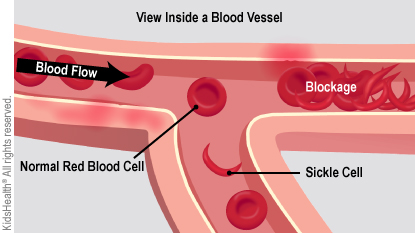Hydroxyurea for People With Sickle Cell Disease
What Is Hydroxyurea?
Hydroxyurea is a medicine that can help people who have sickle cell disease. It keeps blood cells round and flexible, so they flow better and deliver oxygen to the body more easily. This means less pain and fewer trips to the hospital.
What Happens in Sickle Cell Disease?
Healthy red blood cells are soft, flexible, and round. Sickle cell disease makes red blood cells become sticky, hard, and C-shaped. The sickle cells get stuck and block the blood flowing inside small blood vessels. This can be painful and lead to other problems that need to be treated in a hospital.
Sickle cells also break down more quickly than healthy red blood cells. Not having enough red blood cells can lead to anemia. People with anemia feel tired and have less energy.

How Does Hydroxyurea Help People With Sickle Cell Disease?
Hydroxyurea (hy-drok-see-yer-EE-uh) helps the body make a type of hemoglobin that helps keep red blood cells round. Hemoglobin is the protein inside red blood cells that carries oxygen to the body. Round and flexible red blood cells work better and last longer. So people who take hydroxyurea can have more energy, and less pain and anemia. They often spend less time in the hospital.
Who Can Take Hydroxyurea?
Hydroxyurea can help people with sickle cell disease, including those who have:
- some types of sickle cell disease (like the most common type, called hemoglobin SS)
- lots of pain crises (some people get these often, but others don’t)
- acute chest syndrome
- severe anemia needing blood transfusions
- tiny blockages without any pain. Sickle cells can scrape the inside of blood vessels. This creates small places for blood cells to get stuck and form a blockage. A blockage that stays small might not cause pain, but it can still prevent blood and oxygen from getting where they need to go.
Children as young as 9 months old can take hydroxyurea.
Doctors sometimes use hydroxyurea to treat other kinds of health problems, not just sickle cell disease. Like many medicines, it has different uses. In high doses, it can help with some kinds of blood cancers. The dose used to treat sickle cell disease is very low.
How Do Children Take Hydroxyurea?
Hydroxyurea comes as either a liquid medicine or a small capsule that your child or teen swallows one time each day. It works best when they take it at the same time every day. Some people find it helps to set an alarm to stay on schedule.
Before your child starts taking the medicine, your care team will order a blood test to figure out the starting dose. Then they’ll order monthly blood tests to see how the medicine is working. As hydroxyurea boosts a person’s healthy red blood cells, it sometimes can affect other blood cells. Regular blood tests help the care team make sure the dose is right. They can change the dose or stop the medicine, if needed.
It can take a few months to find the right dose. After that, your child will get blood tests less often.
Does Hydroxyurea Cause Side Effects?
Most people who take hydroxyurea do well and don’t notice any side effects. Those who do might have dark fingernails or headaches. Often, side effects go away quickly as a person adjusts to the new medicine.
How Much Does Hydroxyurea Cost?
Hydroxyurea is usually paid for by insurance. Your cost (if any) will depend on the type of insurance you have. Your child's doctor’s office will help you find out if there are costs for you.
If the care team recommends hydroxyurea for your child, talk to them if you have questions or concerns. If your child is old enough, include them in the discussion too. Together you can make a choice you both can feel good about.
Reviewed by: Corinna L. Schultz, MD
Date Reviewed: Nov 1, 2022
















